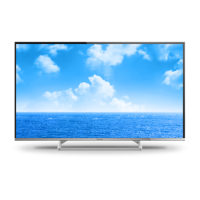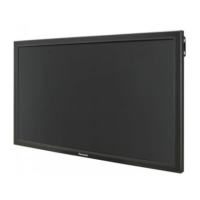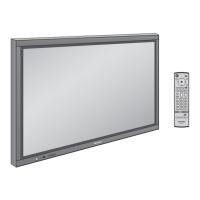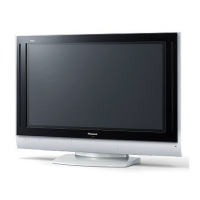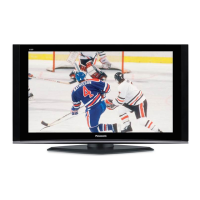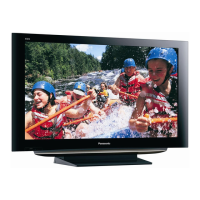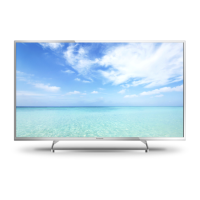Do you have a question about the Panasonic TH-60AS740A and is the answer not in the manual?
Defines the 'my Home Screen' as a gateway to TV, applications, and other features.
Explains how to display and navigate the Home Screen and access features.
Details how to customize the Home Screen, including wallpaper and screen layout.
Allows selection of preferred color types for on-screen displays.
Provides information on accessing various applications easily from the APPS List.
Explains how to access special features like internet contents and Media Player from APPS List.
Details how to customize APPS List settings, such as screen settings.
Covers basic TV watching operations, including connections and channel selection.
Explains how to connect and watch external equipment like VCRs and set-top boxes.
Provides guidance on optimizing picture quality through various settings.
Allows selection of favorite sound modes for each input.
Adjusts levels for Bass, Treble, Equaliser, Balance, Surround, and Bass Boost.
Covers TV Speaker, Auto Gain Control, Volume Correction, and Speaker Distance to Wall.
Configures voice guidance for basic features for visually impaired users.
Provides narration settings for visually impaired users.
Details advanced sound settings like MPX, Digital Audio Preference, and SPDIF Selection.
Explains how to use the Electronic Programme Guide for program listings.
Allows setting timers to watch or record forthcoming programmes.
Provides important notes and precautions for viewing 3D content.
Covers proper storing and cleaning procedures for 3D eyewear.
Explains how to enjoy 3D images with compatible content and eyewear.
Allows changing viewing mode between 2D and 3D formats.
Configures 3D detection, signal messages, depth, and adjustment settings.
Helps identify correct 3D mode and source image format for abnormal pictures.
Accesses menus for retuning channels and managing channel lists.
Allows creation and editing of favorite digital TV channel lists.
Enables skipping unwanted channels or editing existing ones.
Automatically searches for and retunes receivable channels.
Provides manual tuning for digital and analogue TV channels.
Updates the channel list automatically while retaining settings.
Configures notification messages for new digital TV channels.
Checks the signal condition for selected channels.
Adds TV modes, useful if modes were skipped during initial setup.
Details preparation and setup for using USB HDD for recording.
Explains formatting and setting up the USB HDD for recording.
Covers One Touch Recording and playing back recorded contents.
Allows setting timers to record or remind about forthcoming programmes.
Provides technical details about USB HDD compatibility and usage.
Introduction to enjoying photos, videos, music, and recorded TV via Media Player.
Details selecting and viewing photo files, including slideshow settings.
Explains selecting and watching video files, including playback controls.
Configures multi-channel sound output via HDMI or Digital Audio Out.
Guides on selecting recorded content for playback from the list.
Details playback operations for recorded TV programs.
Explains how to group and manage recorded contents.
Provides instructions on how to delete recorded content.
Allows switching between connected devices for playback.
Enables playback from a chapter list within recorded content.
Configures digital audio output signals from HDMI and Digital Audio Out terminals.
Guides on selecting music files from folders for playback.
Details playback operations for music files.
Covers settings for music playback, including repeat options.
Explains how to copy contents between devices using USB ports and SD card slots.
Provides important cautions for handling storage devices like USB and SD cards.
Details SD card standards, formats, and compliant types.
Information on USB Flash Memory and USB HDD compatibility and usage.
Lists supported photo formats and their specifications.
Details supported video formats, codecs, and container types.
Lists supported subtitle file formats and their requirements.
Details supported music file formats and their compatibility.
Explains how to access websites and internet content via APPS List.
Information about DLNA Certified products and home network usage.
Details wireless and wired connections for internet and DLNA services.
Guides on wireless and wired connections for DLNA and internet services.
Covers quick setup for wireless and wired network connections.
Manual setup for wireless network connection, including WPS and manual modes.
Manual setup for wired network connection, including IP/DNS settings.
Enables using the TV as a wireless access point.
Displays and checks the current network status.
Provides information on cloud services and account setup.
Allows setting a favorite name for the TV on the network.
Configures settings for controlling the TV with network equipment.
Sets control of TV with network-connected devices, including DLNA Server.
Enables watching TV and setting timers remotely via network equipment.
Lists accessible network devices for playing back contents in Media Player.
Checks for and downloads TV software updates from the Panasonic website.
Configures notification messages for new software found via network.
Guides on selecting photo files from media servers for viewing.
Details playback operations for photo files, including slideshow.
Covers slideshow settings like frame type, transition effects, and background music.
Guides on selecting video files from media servers for playback.
Details playback operations for video files, including controls and aspect ratio.
Covers video playback settings like preview, audio selection, and subtitles.
Configures digital audio output signals for multi-channel sound.
Guides on selecting music files from folders for playback.
Details playback operations for music files, including controls.
Covers music playback settings, including repeat options.
Explains how to control a DIGA Recorder via the TV's remote control.
Lists supported photo formats, sub-sampling, and resolution.
Details supported video formats, codecs, and container types.
Lists supported subtitle file formats and requirements.
Details supported music file formats and compatibility.
Allows setting up user profiles for personalized content and settings.
Explains how to operate the TV using voice commands.
Information and setup for using the Touch Pad Controller.
Enables viewing TV programmes or external input in two windows simultaneously.
Summary of VIERA Link features for HDMI Inter-Operability.
Allows locking channels or AV inputs to restrict access.
Explains how to use Hybrid Broadcast Broadband TV applications.
Covers storing and deleting technical information for data service applications.
Resets the TV to its original condition, excluding USB Device Setup.
Provides information on new software releases to enhance TV performance.
Explains how to update TV software automatically.
Guides on manually updating the TV software via the internet.
Explains how to enter characters for input items using numeric buttons.
Details setup for Bluetooth keyboards, mice, and audio devices.
Maps keyboard keys to remote control functions for TV operation.
Guides on navigating menus to make settings for picture, sound, and other functions.
Covers picture settings like Viewing Mode, Basic settings, and Advanced Settings.
Details sound settings including Mode, Basic settings, and Volume settings.
Provides network settings like connection, status, and VIERA Name.
Covers timer functions like Off Timer, Timer Programming, and Clock Settings.
Includes Eco Navigation, Voice Control, User Settings, and device setups.
Troubleshooting guide for common picture, digital TV, sound, HDMI, and network issues.
Provides instructions for care and cleaning of the TV components.
Explains how to use the Help menu for TV self-tests and system information.
Information on optional accessories like 3D Eyewear and Communication Camera.
Details product trademarks, software licenses, and copyrights.
Defines the 'my Home Screen' as a gateway to TV, applications, and other features.
Explains how to display and navigate the Home Screen and access features.
Details how to customize the Home Screen, including wallpaper and screen layout.
Allows selection of preferred color types for on-screen displays.
Provides information on accessing various applications easily from the APPS List.
Explains how to access special features like internet contents and Media Player from APPS List.
Details how to customize APPS List settings, such as screen settings.
Covers basic TV watching operations, including connections and channel selection.
Explains how to connect and watch external equipment like VCRs and set-top boxes.
Provides guidance on optimizing picture quality through various settings.
Allows selection of favorite sound modes for each input.
Adjusts levels for Bass, Treble, Equaliser, Balance, Surround, and Bass Boost.
Covers TV Speaker, Auto Gain Control, Volume Correction, and Speaker Distance to Wall.
Configures voice guidance for basic features for visually impaired users.
Provides narration settings for visually impaired users.
Details advanced sound settings like MPX, Digital Audio Preference, and SPDIF Selection.
Explains how to use the Electronic Programme Guide for program listings.
Allows setting timers to watch or record forthcoming programmes.
Provides important notes and precautions for viewing 3D content.
Covers proper storing and cleaning procedures for 3D eyewear.
Explains how to enjoy 3D images with compatible content and eyewear.
Allows changing viewing mode between 2D and 3D formats.
Configures 3D detection, signal messages, depth, and adjustment settings.
Helps identify correct 3D mode and source image format for abnormal pictures.
Accesses menus for retuning channels and managing channel lists.
Allows creation and editing of favorite digital TV channel lists.
Enables skipping unwanted channels or editing existing ones.
Automatically searches for and retunes receivable channels.
Provides manual tuning for digital and analogue TV channels.
Updates the channel list automatically while retaining settings.
Configures notification messages for new digital TV channels.
Checks the signal condition for selected channels.
Adds TV modes, useful if modes were skipped during initial setup.
Details preparation and setup for using USB HDD for recording.
Explains formatting and setting up the USB HDD for recording.
Covers One Touch Recording and playing back recorded contents.
Allows setting timers to record or remind about forthcoming programmes.
Provides technical details about USB HDD compatibility and usage.
Introduction to enjoying photos, videos, music, and recorded TV via Media Player.
Details selecting and viewing photo files, including slideshow settings.
Explains selecting and watching video files, including playback controls.
Configures multi-channel sound output via HDMI or Digital Audio Out.
Guides on selecting recorded content for playback from the list.
Details playback operations for recorded TV programs.
Explains how to group and manage recorded contents.
Provides instructions on how to delete recorded content.
Allows switching between connected devices for playback.
Enables playback from a chapter list within recorded content.
Configures digital audio output signals from HDMI and Digital Audio Out terminals.
Guides on selecting music files from folders for playback.
Details playback operations for music files.
Covers settings for music playback, including repeat options.
Explains how to copy contents between devices using USB ports and SD card slots.
Provides important cautions for handling storage devices like USB and SD cards.
Details SD card standards, formats, and compliant types.
Information on USB Flash Memory and USB HDD compatibility and usage.
Lists supported photo formats and their specifications.
Details supported video formats, codecs, and container types.
Lists supported subtitle file formats and their requirements.
Details supported music file formats and their compatibility.
Explains how to access websites and internet content via APPS List.
Information about DLNA Certified products and home network usage.
Details wireless and wired connections for internet and DLNA services.
Guides on wireless and wired connections for DLNA and internet services.
Covers quick setup for wireless and wired network connections.
Manual setup for wireless network connection, including WPS and manual modes.
Manual setup for wired network connection, including IP/DNS settings.
Enables using the TV as a wireless access point.
Displays and checks the current network status.
Provides information on cloud services and account setup.
Allows setting a favorite name for the TV on the network.
Configures settings for controlling the TV with network equipment.
Sets control of TV with network-connected devices, including DLNA Server.
Enables watching TV and setting timers remotely via network equipment.
Lists accessible network devices for playing back contents in Media Player.
Checks for and downloads TV software updates from the Panasonic website.
Configures notification messages for new software found via network.
Guides on selecting photo files from media servers for viewing.
Details playback operations for photo files, including slideshow.
Covers slideshow settings like frame type, transition effects, and background music.
Guides on selecting video files from media servers for playback.
Details playback operations for video files, including controls and aspect ratio.
Covers video playback settings like preview, audio selection, and subtitles.
Configures digital audio output signals for multi-channel sound.
Guides on selecting music files from folders for playback.
Details playback operations for music files, including controls.
Covers music playback settings, including repeat options.
Explains how to control a DIGA Recorder via the TV's remote control.
Lists supported photo formats, sub-sampling, and resolution.
Details supported video formats, codecs, and container types.
Lists supported subtitle file formats and requirements.
Details supported music file formats and compatibility.
Allows setting up user profiles for personalized content and settings.
Explains how to operate the TV using voice commands.
Information and setup for using the Touch Pad Controller.
Enables viewing TV programmes or external input in two windows simultaneously.
Summary of VIERA Link features for HDMI Inter-Operability.
Allows locking channels or AV inputs to restrict access.
Explains how to use Hybrid Broadcast Broadband TV applications.
Covers storing and deleting technical information for data service applications.
Resets the TV to its original condition, excluding USB Device Setup.
Provides information on new software releases to enhance TV performance.
Explains how to update TV software automatically.
Guides on manually updating the TV software via the internet.
Explains how to enter characters for input items using numeric buttons.
Details setup for Bluetooth keyboards, mice, and audio devices.
Maps keyboard keys to remote control functions for TV operation.
Guides on navigating menus to make settings for picture, sound, and other functions.
Covers picture settings like Viewing Mode, Basic settings, and Advanced Settings.
Details sound settings including Mode, Basic settings, and Volume settings.
Provides network settings like connection, status, and VIERA Name.
Covers timer functions like Off Timer, Timer Programming, and Clock Settings.
Includes Eco Navigation, Voice Control, User Settings, and device setups.
Troubleshooting guide for common picture, digital TV, sound, HDMI, and network issues.
Provides instructions for care and cleaning of the TV components.
Explains how to use the Help menu for TV self-tests and system information.
Information on optional accessories like 3D Eyewear and Communication Camera.
Details product trademarks, software licenses, and copyrights.

